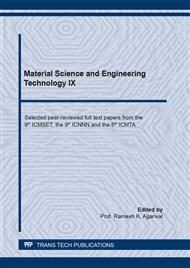[1]
Iijima S. Helical microtubules of graphitic carbon. nature, 1991, 354(6348): 56–58.
DOI: 10.1038/354056a0
Google Scholar
[2]
Zapata-Solvas E, Gómez-García D, Domínguez-Rodríguez A. Towards physical properties tailoring of carbon nanotubes-reinforced ceramic matrix composites. Journal of the European Ceramic Society, 2012, 32(12): 3001–3020.
DOI: 10.1016/j.jeurceramsoc.2012.04.018
Google Scholar
[3]
Yamamoto G, Shirasu K, Nozaka Y, et al. Microstructure–property relationships in pressureless-sintered carbon nanotube/alumina composites. Materials Science and Engineering: A, 2014, 617: 179–186.
DOI: 10.1016/j.msea.2014.08.068
Google Scholar
[4]
Nam T H, Goto K, Yamaguchi Y, et al. Effects of CNT diameter on mechanical properties of aligned CNT sheets and composites. Composites Part A: Applied Science and Manufacturing, 2015, 76: 289–298.
DOI: 10.1016/j.compositesa.2015.06.009
Google Scholar
[5]
Rafiee R, Moghadam R M. On the modeling of carbon nanotubes: a critical review. Composites Part B: Engineering, 2014, 56: 435–449.
DOI: 10.1016/j.compositesb.2013.08.037
Google Scholar
[6]
Shirasu K, Yamamoto G, Hashida T. How do the mechanical properties of carbon nanotubes increase? An experimental evaluation and modeling of the engineering tensile strength of individual carbon nanotubes. Materials Research Express, 2019, 6(5): 055047.
DOI: 10.1088/2053-1591/ab069f
Google Scholar
[7]
Shen G A, Namilae S, Chandra N. Load transfer issues in the tensile and compressive behavior of multiwall carbon nanotubes. Materials Science and Engineering: A, 2006, 429(1-2): 66–73.
DOI: 10.1016/j.msea.2006.04.110
Google Scholar
[8]
Peng B, Locascio M, Zapol P, et al. Measurements of near-ultimate strength for multiwalled carbon nanotubes and irradiation-induced crosslinking improvements. Nature nanotechnology, 2008, 3(10): 626.
DOI: 10.1038/nnano.2008.211
Google Scholar
[9]
Plimpton S. Fast parallel algorithms for short-range molecular dynamics, J Comp Phys, 117, 1–19 (1995). (http://lammps.sandia.gov).
Google Scholar
[10]
Byrne E M, McCarthy M A, Xia Z, et al. Multiwall nanotubes can be stronger than single wall nanotubes and implications for nanocomposite design. Physical review letters, 2009, 103(4): 045502.
DOI: 10.1103/physrevlett.103.045502
Google Scholar
[11]
Duan W H, Wang Q, Liew K M, et al. Molecular mechanics modeling of carbon nanotube fracture. Carbon, 2007, 45(9): 1769–1776.
DOI: 10.1016/j.carbon.2007.05.009
Google Scholar
[12]
Lu X, Hu Z. Mechanical property evaluation of single-walled carbon nanotubes by finite element modeling. Composites Part B: Engineering, 2012, 43(4): 1902–(1913).
DOI: 10.1016/j.compositesb.2012.02.002
Google Scholar
[13]
Stuart S J, Tutein A B, Harrison J A. A reactive potential for hydrocarbons with intermolecular interactions. The Journal of chemical physics, 2000, 112(14): 6472–6486.
DOI: 10.1063/1.481208
Google Scholar
[14]
Zhao H, Min K, Aluru N R. Size and chirality dependent elastic properties of graphene nanoribbons under uniaxial tension. Nano letters, 2009, 9(8): 3012–3015.
DOI: 10.1021/nl901448z
Google Scholar
[15]
Choi B K, Yoon G H, Lee S. Molecular dynamics studies of CNT-reinforced aluminum composites under uniaxial tensile loading. Composites Part B: Engineering, 2016, 91: 119–125.
DOI: 10.1016/j.compositesb.2015.12.031
Google Scholar
[16]
Deb Nath S K, Kim S G. Study of the nanomechanics of cnts under tension by molecular dynamics simulation using different potentials. ISRN Condensed Matter Physics, 2014, (2014).
DOI: 10.1155/2014/606017
Google Scholar
[17]
Thamaraikannan S, Pradhan S C. Atomistic Study of Carbon Nanotubes: Effect of Cut-Off Distance//TMS 2016 145th Annual Meeting & Exhibition. Springer, Cham, 2016: 293–300.
DOI: 10.1007/978-3-319-48254-5_36
Google Scholar
[18]
Jhon Y I, Jhon Y M, Yeom G Y, et al. Orientation dependence of the fracture behavior of graphene. Carbon, 2014, 66: 619–628.
DOI: 10.1016/j.carbon.2013.09.051
Google Scholar
[19]
Yamamoto G, Shirasu K, Nozaka Y, et al. Structure-property relationships in thermally-annealed multi-walled carbon nanotubes. Carbon, 2014, 66: 219–226.
DOI: 10.1016/j.carbon.2013.08.061
Google Scholar
[20]
Qian J, Nguyen N P, Oya Y, et al. Introducing self-organized maps (SOM) as a visualization tool for materials research and education. Results in Materials, 2019, 4: 100020.
DOI: 10.1016/j.rinma.2019.100020
Google Scholar


